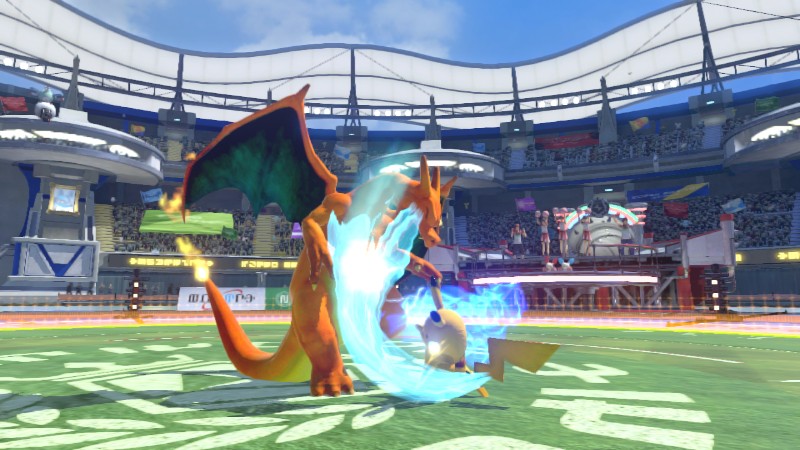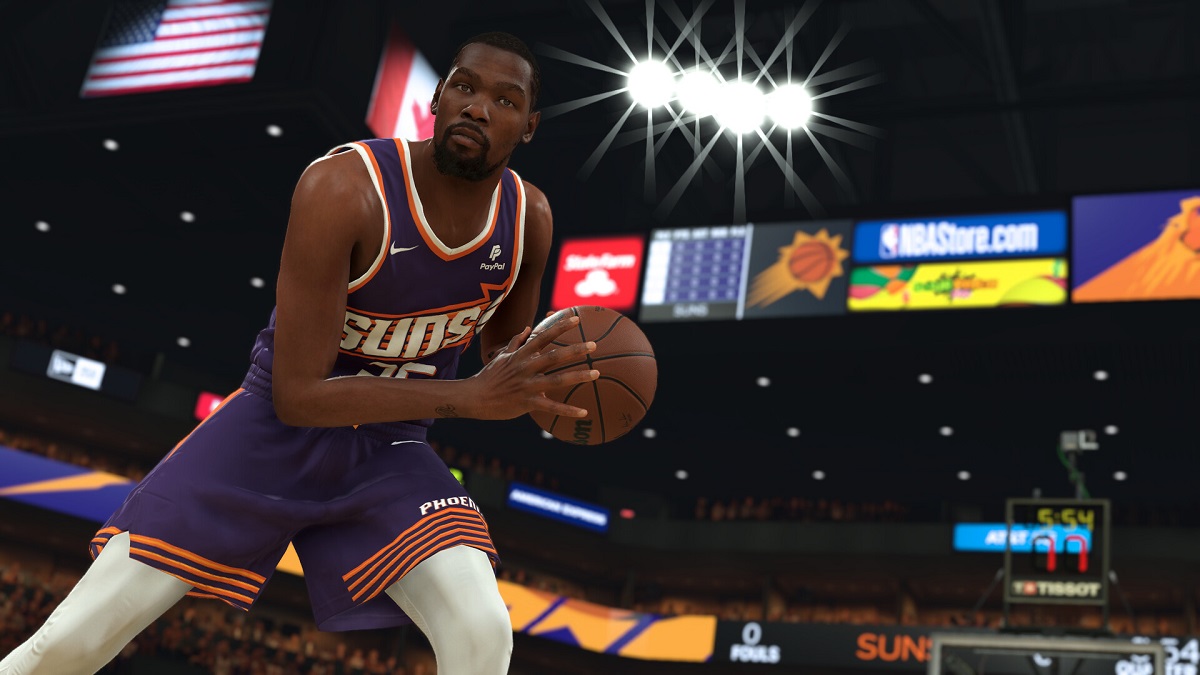You’ve stumbled across Pokken Profile, a series of character guides that aim to teach the fundamentals of playing every fighter on the roster at a competitive level. To share these tips with you, I’ve studied tirelessly under the humble gurus of Pokken Tournament‘s warm and growing community. These profiles will detail every characters’ strengths and weaknesses and offer advice on how to draw out their potential to cover their shortcomings.
Pokken Profile uses numpad notation to refer to moves that are performed in Duel Phase.
- Numpad notation refers to the D-pad as if it were a calculator or keyboard numpad, indicating which direction to press.
- For example, 6A is ‘Forward + A’ (P1 position is assumed), while 5A is just tapping A without a directional input.
- Buttons surrounded by brackets must be charged or held.
- For example, 6[X] is ‘Forward + charged X’. Only X needs to be held.
- The tilde indicates a delay, requiring the next button press to be precisely timed for the desired move or combo to execute successfully.
- For example, 6Y~Y is “Forward + Y + Delayed Y”.
- Moves available exclusively in Field Phase are referred to with directional annotations, such as bY for ‘Back + Y’.
- If a move can be used in both Duel and Field Phase, then it is written in numpad notation from Duel Phase Player 1 (left-side) perspective.
Pikachu, much like Lucario, is a rather balanced character. To top it all off, he moves as quick as lightning and paralyzes his foes with an electrifying moveset. Ultimately, Pikachu is so well-rounded that he can take on any opponent on the roster. He has a weak burst attack and next-to-no options on wake up, but a skilled Pikachu still strikes terror into the hearts of their enemies.
Pikachu’s Strengths
Pikachu is fast and nimble like a Speed character. However, Pikachu is classified as a Standard character in Pokken Tournament, meaning he has a diverse move pool to play with. Not only can Pikachu put on the pressure, he has the tools to counter someone trying to zone him. To top it all off, Pikachu has an infamously quick charging Synergy Burst gauge that lets him get away with Bursting once or twice every round.
Wake Up Options
Unfortunately, Pikachu has a weak wake up game, though there are a few moves that can really help out in a cinch. As always, remember that block is a perfectly valid option that keeps your safe from counter pierce.
8A, or Volt Tackle, is a perfectly good wake up option in a pinch. It’s quick to start, has counter properties, and launches your opponent into the air, much like Lucario’s own 8A, Extreme Speed. Never, under any circumstances, use this as a panic button; your opponent will catch on and punish you.

2A, or Iron Tail, is a great mix-up for Volt Tackle. It has a fast start up and takes you into high-profile to dodge lower attacks. Best of all, Iron Tail has a lot of armor so it beats out most attacks.
8X, on the other hand, is perfect when you read a grab. Even if you get caught in the startup animation, the attack will still go through your opponent’s grab attempt (rather than canceling and resetting the playing field to neutral).
When you knock down your opponent, Pikachu doesn’t have any safe options. You probably just want to return the field to neutral, waiting for your opponent to get up from a distance. Otherwise, feel free to take your chances with Rock, Paper, Scissors and whatever mind games you can muster.
Approaches and Pokes
In field phase, Pikachu is best sticking to homing attack block cancels to get to mid-close range. He does have a lower priority homing projectile on jY that can be used to distract your opponent as you approach, but otherwise Pikachu doesn’t have any amazing options.
In duel phase, however, BX is a fantastic approach tool. The midair X has a ton of armor, and propels your forward and down, even giving Pikachu the time to charge [Y] for a potential followup.
What Pikachu lacks in approach options he makes up for in projectiles and pokes. Thunder on jA is a great tool to keep your opponent from zoning you, but it comes out too slow to use reliably at any other point. Pikachu’s Y projectiles will force the opponent to react.
2Y is a great low stance poke. It doesn’t propel Pikachu and it has some distance on it. It comes out and recovers quickly and won’t add many phase shifts points if it hits. Iron Tail is its natural Pokecombo follow up if you want to give ’em a good smack.
2X is another low stance poke very similar to 2Y. Unlike it, however, it propels Pikachu forward and hits the opponent twice. This move even launches your aggressor into the air.
5X is another low, swift poke that can launch your opponent, though not quite to the extent of 2X. It Pokecombos into Thunderbolt, which isn’t great, but it’s not bad either so long as you’re not following up on block.
Mixups
Pikachu has the most kick-ass mixup tool in Pokken Tournament: blue 6Y. If you press 6 (forward) and Y at the exact same time, the move comes out blue and hits for 90 points of damage, launching your opponent into the air. This move is also prime combo-starter material. Practice the timing on both sides in Free Training, and you’ll have your opponents cowering behind their shields in no time.
8Y is an aerial mixup tool, a great alternative to jumping. This tail uppercut has armor, and the attack ends with Pikachu in the air, so you can follow it up with a midair move. This can even work as a decent anti air if your opponent is nearby, though 4A will always be the better choice for that.
Charging 5[A] (Thunderbolt) rather than just tapping it is a good mixup option. In Duel phase, it will send out two bolts of lighting, while in field phase, it will cover extra ground in a triple bolt lash. Swap between charged and uncharged versions to throw off your opponent.
6A (Nuzzle) is a great alternative to grab. It does less damage, though it beats out other grabs and will keep you in Duel Phase. When used from Duel Phase, Nuzzle may even be used to confirm into Pikachu’s Burst Attack, particularly against larger foes. Against smaller opponents, you’ll have to time your Burst Attack least you risk zipping right under them.
Bread and Butter Combos
Pikachu has some of the most straightforward combos in Pokken Tournament, making him one of the easier character to pick up and learn.
- [Counter](crit)5YYYY – Pikachu’s counter has a huge hitbox, so you may not always be able to pull this off, but if you get off a crit counter in duel phase, you can quickly combo it into 5Y. You can even interrupt your Y string with an X button press if you want to mix it up.
- 6A5A – On any successful 6A (Nuzzle) in Duel Phase, you have the chance to combo it into a 5A (Thunderbolt) for that extra sliver of damage.
- 6Y6Y6Y – When the forward press and Y press are timed in-sync, the demoralizing blue 6Y cracks out. If you’re good at cracking out the blue 6Y, use it, abuse it, and make them fear your blue fist. If you’re not good at it, don’t use this combo. The yellow 6Y adds far more Phase Shift points than the blue variant. It may seem unoriginal, but juggling the opponent with blue 6Y is nightmare fuel.
- 6Y6Y2X2A – Not so good at cracking out blue 6Y? You should practice, but that’s all right, because even if you miss your blue 6Ys, yellow 6Y is still a fantastic combo starter. Crack out a couple of 6Ys, keep them in the air with 2X and finish off the combo with 2A (Iron Tail).
Synergy Burst
While Pikachu doesn’t get a Mega in Synergy Burst form, he becomes a supercharged ball of electric fury. Many of his moves will upgrade and change for the duration of his short Synergy Burst mode.
- BA – Midair A (Thunder) becomes a double hit move in Synergy Burst, which many opponents don’t expect. The lightning strikes like normal, then a blue strike hits a few moments later.
- 8AA – Like Lucario, Pikachu gets a followup to his quick-counter 8A (Volt Tackle). Pressing A again midair will launch you back down to the ground. If you manage to hit your opponent with the followup, it causes a guaranteed phase shift.
- 6Y – Whether you nail your timing or not, Pikachu’s 6Ys will always come out supercharged and blue in Synergy Burst. You would do well to abuse this.
- [Y] – Normally, a charged [Y] comes out blue when you release it while walking forward. In Synergy Mode, Pikachu’s charged [Y] will always come out blue, no matter which way you’re moving.
It’s a good idea to confirm Pikachu’s Burst Attack with 6A (Nuzzle), or 2Y. Otherwise, the Burst Attack also acts as a great gap closer, considering how fast you recover from it if you miss. Don’t forget to use it; Pikachu’s Synergy Gauge runs out quickly.
Support Pokemon
There are a number of Support Pokemon sets that compliment Pikachu’s moveset. Rotom and Togekiss immediately come to mind. Pikachu can easily use Rotom to restrict foes from acting, and can uppercut them into it with 6Y. Togekiss makes the nimble electric mouse even quicker, making Pikachu a far deadlier threat in Field and Duel Phase.
Jirachi and Whimsicott is another good set, mostly for Jirachi’s Synergy Burst buff. While in Synergy Burst with Jirachi’s buff on, you will take far less damage and deal a lot more.
Another set you may want to consider is Croagunk and Sylveon. Croagunk will lower the defense of opponents caught within its circle, even if they’re blocking. Sylveon is less useful, but the extra defense and health she provides may help out in a pinch.
Cheer Skill
Pikachu’s Synergy Gauge charges so quickly that they’re no reason to use anything other than the Support Cheer. The Support Cheer Skill will raise your Support Pokemon’s gauges to max after every round, no matter the outcome of the previous round. You don’t need the extra Synergy boost from Standard, so don’t use it.
Pikachu’s Weaknesses
Pikachu, like Lucario, is a jack of all trades, master of none. Hell, Pikachu doesn’t even get a crazy Syngergy Burst Mega form like Lucario does. A good Pikachu player will master all of the tools he or she has available and know when to use them. A good Pikachu player also practices their blue 6Y timing. Never underestimate the power of the blue 6Y.
Be sure to check out the Pokken Tournament community over at PokkenArena and /r/PokkenGame. Detailed resources — like this frame data — and helpful, active members are littered all about. Do you have any tips and tricks for Pikachu? Chime in to the comments below!









Published: May 25, 2016 08:47 am